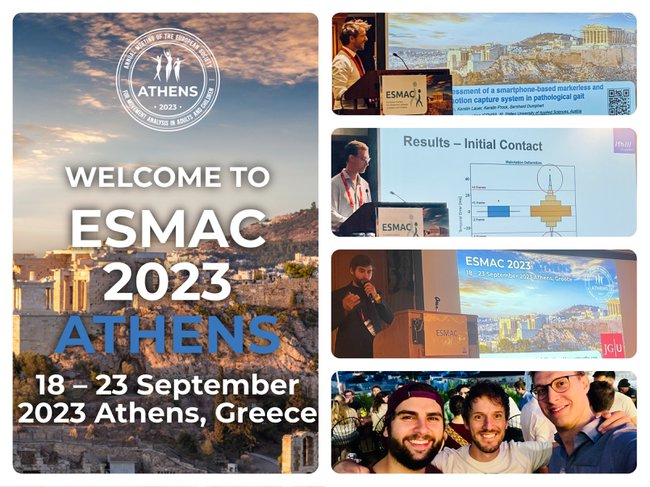3rd Place in Best Paper Award
The European Society for Movement Analysis in Adults and Children (ESMAC) is one of the most important conferences in the field of gait analysis in Europe. This year’s event was held in Athens and the St. Pölten UAS contributed several submissions.
The presentations of Djordje Slijepcevic from the ICMT and Bernhard Dumphart from the IGW and the CDHSI on machine learning in gait analysis met with a lot of attention. As in all spheres of medicine, methods of machine learning are gaining more and more importance in clinical gait analysis as well. The works dedicated to the topics of “explainable AI” and “automated pattern recognition” in gait analysis can undoubtedly be described as groundbreaking in this community.
Special Distinction
Another highlight was the third place in the Best Paper Award for Brian Horsak and his team who were more than glad about this distinction.
The award-winning project examined how two simple smartphones, machine learning, cloud computing, and complex musculoskeletal simulations take the gait analysis lab to the patients, as it were, instead of bringing the patients to the lab (which is the usual method) – a highly innovative approach that could become particularly interesting for large-scale field studies in the future.
Yet maybe the greatest thing about this success is the fact that the paper resulted from a double master thesis in the continuing education programme “Gait Analysis and Rehabilitation” at the St. Pölten UAS, both under the supervision of Brian Horsak – truly a prime example of the interconnection of teaching and research. Incidentally, the thesis was also recently published in the Journal of Biomechanics together with the two graduates Kerstin Lauer and Anna Eichmann.
The two presentations held by Djordje Slijepcevic and Bernhard Dumphart
- Dumphart, B., Slijepcevic, D., Kranz, A., Zeppelzauer, M., & Horsak, B. (2023). Is it time to re-think the appropriateness of autocorrelation for gait event detection? Preliminary results of an ongoing study. Gait & Posture, 106, 50–51. https://doi.org/10.1016/j.gaitpost.2023.07.064
- Slijepcevic, D., Horst, F., Simak, M., Schöllhorn, W. I., Zeppelzauer, M., & Horsak, B. (2023). Towards personalized gait rehabilitation: How robustly can we identify personal gait signatures with machine learning? Gait & Posture, 106, 192–193. https://doi.org/10.1016/j.gaitpost.2023.07.232
The award-winning paper
- Horsak, B., Eichmann, A., Lauer, K., Prock, K., Krondorfer, P., Siragy, T., & Dumphart, B. (2023). Concurrent validity of smartphone-based markerless motion capturing to quantify lower-limb joint kinematics in healthy and pathological gait. Journal of Biomechanics, 159, 111801. https://doi.org/10.1016/j.jbiomech.2023.111801
Further information
- Center for Digital Health and Social Innovation (CDHSI)
- Institute of Creative\Media/Technologies (ICMT)
- Institute of Health Sciences (IGW)
- Continuing education programme Gait Analysis and Rehabilitation
- European Society for Movement analysis in Adults and Children (ESMAC)

